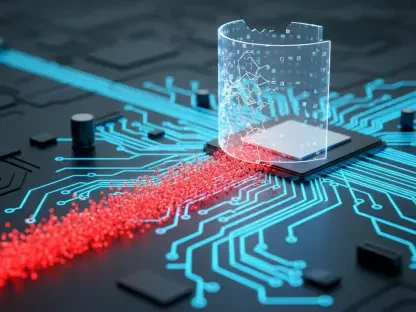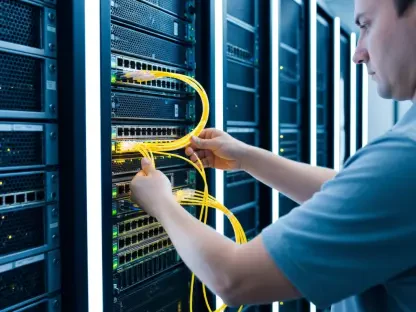The rapid evolution of data storage technology has prompted significant shifts in the market, grappled with by consumers and enterprises alike. Recent explorations into this dynamic field suggest a fascinating competition and symbiosis between Hard Disk Drives (HDDs) and Solid State Drives (SSDs). This fusion of rivalry and cooperation is shaping a storage landscape that is evolving quickly yet predictably. The complexity of this ecosystem becomes clear when one delves into the roles each technology plays, the economic factors driving storage choices, and the technological advancements and limitations that define them.
Evolution of Data Storage Markets
The data storage market is undergoing a significant transformation, marked by the increasing prominence of SSDs and their superior speed and efficiency. SSDs, initially prevalent in high-performance laptops and personal computers, are now progressively penetrating data centers where rapid data access is paramount. This shift is driven by the decreasing costs of flash-based SSDs and their unparalleled performance in random access scenarios. Users are gravitating towards SSDs not only for the speed but also for the reliability and lower power consumption they offer compared to traditional HDDs.
On the other hand, HDDs continue to be the backbone of bulk data storage solutions, particularly for enterprises requiring extensive and cost-effective storage. Despite the advancements and popularity of SSDs, HDDs remain indispensable due to their lower cost per bit for massive, less-frequently accessed, and sequential data storage. Enterprises continue to rely on HDDs for their expansive data storage needs, leveraging their ability to store vast amounts of data economically. The balance between the speed of SSDs and the cost-effectiveness of HDDs ensures that both technologies have distinct, irreplaceable roles in the storage market.
Economic Factors Driving Storage Choices
Economic considerations greatly influence the choice between HDDs and SSDs, and the continually decreasing cost per bit of HDDs sustains their relevance. This trend is projected to persist, making HDDs a viable choice for large-scale storage needs. The IEEE report indicates that while SSD capacities are increasing, the cost reduction rate is slowing down as technological complexity rises. Each additional layer in 3D NAND technology compounds the cost, thus slowing the rate of price decline for SSDs. This economic reality ensures that HDDs remain a compelling option for bulk storage, particularly where budget constraints are significant.
Conversely, SSDs have experienced substantial cost reductions, driven by economies of scale and advancements in manufacturing processes. Despite the slowing improvements, SSDs continue to benefit from these technological advancements. They are becoming more affordable and accessible, making inroads into various data storage applications. The balance between the enduring cost-efficiency of HDDs and the rapid technological advancements of SSDs ensures that both technologies remain competitive. This economic equilibrium supports the coexistence of HDDs and SSDs, each serving different market needs based on their unique advantages.
Technological Capabilities and Limitations
Technological advancements and inherent limitations shape the applications and future prospects of HDDs and SSDs. SSD technology is nearing a critical juncture with Quad-Level Cells (QLC) due to endurance issues, which make further progression to Penta-Level Cells (PLC) currently impractical. These endurance limitations restrict the lifespan and reliability of SSDs for high-intensity use cases. However, advancements in controller technology and error correction methods are continually being developed to mitigate these endurance challenges, extending the viability of SSDs in demanding applications.
HDDs, in contrast, are benefiting from innovations like Heat-Assisted Magnetic Recording (HAMR) and patterned media, which promise to significantly increase capacity and lower costs. These technologies maintain HDDs’ edge in bulk storage, addressing the need for high-capacity storage solutions. Moreover, HDDs excel in sequential data access and exhibit better endurance over extensive use, which is critical for archival and backup applications. The distinct technological capabilities and limitations of HDDs and SSDs ensure their continued relevance in their respective domains, underpinning their coexistence in the evolving storage market.
Future Projections and Innovations
The storage industry shows no signs of slowing down, with future projections indicating significant advancements in both HDD and SSD technologies. The IEEE report highlights that NAND chip density is expected to continue its exponential growth, with layer counts anticipated to exceed 300 by 2027 and potentially surpass 500 by 2029. Such enhancements could lead to a doubling of maximum chip capacities every few years, pushing the boundaries of SSD performance and storage further. These advancements will enhance the efficiency and cost-effectiveness of SSDs, making them more competitive in various storage markets.
Simultaneously, HDD technology is poised for revolutionary advancements. Integrating HAMR and patterned media techniques is set to revolutionize storage densities, potentially achieving 10 Terabits per square inch within the next 15 years. These technologies promise to drastically lower the cost per bit and increase the storage capacity of HDDs, ensuring their continued competitiveness. The parallel advancements in SSD and HDD technologies indicate a vibrant future for the storage industry, characterized by incremental improvements rather than revolutionary changes, thereby assuring their continued coexistence.
Challenges with Scaling Technologies
As storage technologies advance, they face scaling challenges that influence performance and adoption. One persistent challenge for HDDs is access density, which pertains to the I/O operations per second per byte. With increasing storage capacities, maintaining efficient access times and data retrieval speeds becomes crucial. Addressing these bottlenecks is essential for ensuring the continued utility of HDDs in large-scale storage solutions. Innovative strategies such as multi-actuator technology, which enables parallel data access, are being employed to enhance performance. Additionally, NAND caching techniques, like WD’s OptiNAND, are utilized to bridge the performance gap, improving access speeds and ensuring HDDs remain competitive.
SSDs, on the other hand, face challenges related to the increasing complexity of NAND technology. As layer counts in 3D NAND increase, issues such as cell-to-cell interference and potential reliability problems arise. Addressing these challenges requires advancements in controller technology and error correction algorithms to maintain the reliability and performance of SSDs. Moreover, the diminishing returns in cost reduction highlight the need for continued innovation in manufacturing processes to sustain the economic viability of SSDs. These scaling challenges ensure that both HDDs and SSDs will continue to evolve, facing and overcoming different obstacles to meet the growing demands of the storage market.
Coexistence of HDDs and SSDs
The rapid development of data storage technology has ushered in substantial changes in the market, affecting both consumers and enterprises. Recent studies in this dynamic sector highlight an intriguing mix of competition and cooperation between Hard Disk Drives (HDDs) and Solid State Drives (SSDs). This blend of rivalry and collaboration is steering a storage environment that is evolving swiftly yet predictably. Diving deeper into this ecosystem reveals the distinct roles each technology fulfills, economic forces influencing storage decisions, and the technological innovations and constraints that characterize them.
HDDs have traditionally been favored for their large storage capacities and lower costs, making them appealing for archiving and bulk storage solutions. On the other hand, SSDs offer faster data access speeds and greater durability, driving their popularity in consumer electronics and performance-intensive applications. Economic factors, like decreasing SSD prices, are making them more competitive with HDDs, while ongoing advancements in both technologies continue to refine their respective niches. Consequently, the interplay between HDDs and SSDs is crafting a balance where each technology contributes to the evolving needs of the storage market.









